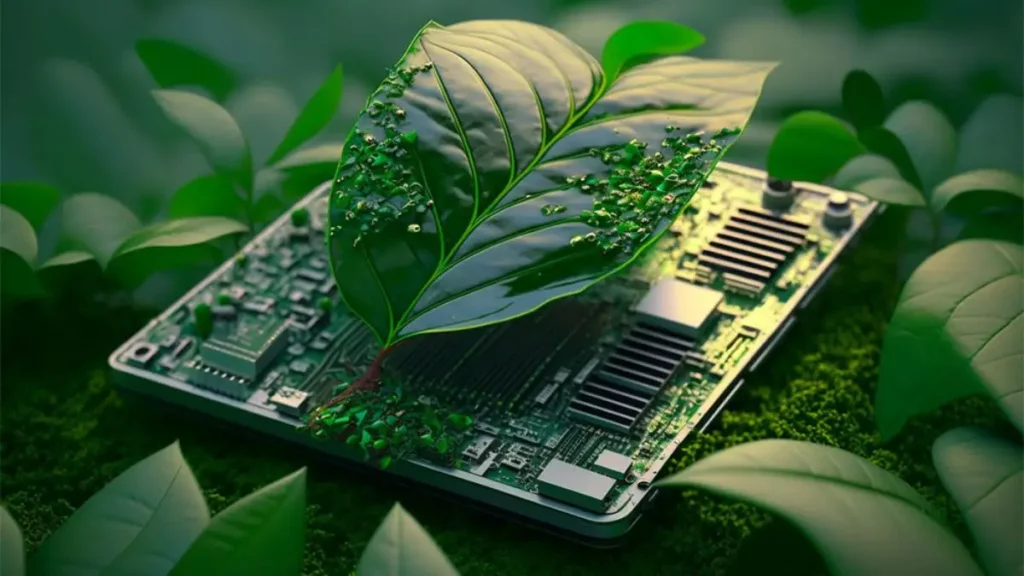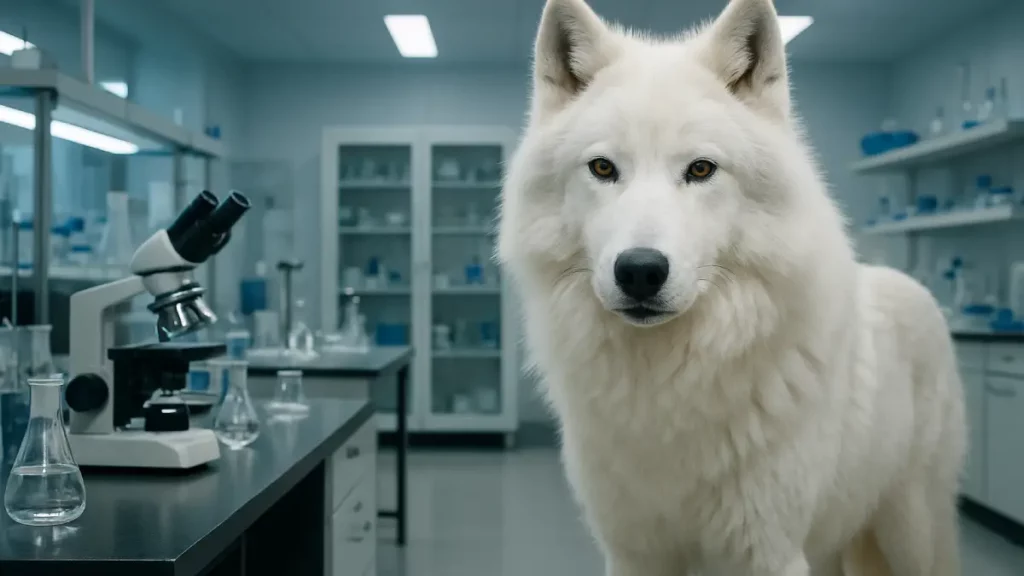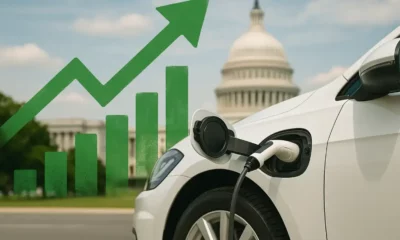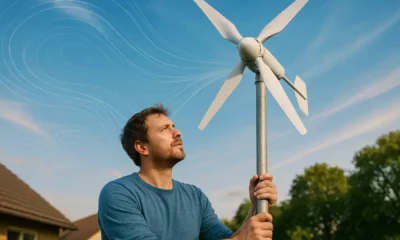AI and Sustainability: How Technology is Building a Greener Future
AI and Sustainability: How Technology is Building a Greener Future
Estimated Reading Time: 9 minutes
Key Takeaways
- AI is Crucial for Sustainability: Artificial Intelligence offers powerful tools to analyze complex environmental data, optimize resource use, and combat climate change, potentially cutting global GHG emissions by 4% by 2030.
- IoT Enables Real-Time Monitoring: The Internet of Things (IoT) creates vast sensor networks for continuous environmental monitoring (air, water, forests), providing crucial data for AI analysis and timely interventions.
- Smart Agriculture Boosts Efficiency: AI-driven precision farming, drone monitoring, and robotics significantly reduce water usage, pesticide application, and emissions while potentially increasing crop yields.
- Energy Management is Key: AI optimizes energy grids, improves renewable energy forecasting, makes buildings smarter, and enables virtual power plants, drastically cutting energy waste and emissions.
- Smart Cities Enhance Urban Life: AI powers intelligent transport, waste management, and urban planning, making cities cleaner, more efficient, and reducing their large environmental footprint.
- Ethical Considerations are Vital: The energy consumption of AI itself, data privacy, and equitable access are significant challenges that need proactive management through green AI practices and responsible deployment.

Table of contents
- AI and Sustainability: How Technology is Building a Greener Future
- Understanding AI’s Role in Sustainability: The Foundation
- IoT in Environmental Monitoring: Creating a Planetary Nervous System
- Smart Agriculture: AI-Powered Farming for Food Security and Environmental Protection
- AI-Driven Energy Management: Powering the Sustainable Future
- Smart City Applications: Creating Urban Sustainability Hubs
- Challenges and Ethical Considerations in AI for Sustainability
- The Future of AI in Sustainability: Emerging Trends and Opportunities
- Conclusion: Building a Sustainable Future with AI
- FAQ
- Additional Resources and References
Our planet faces big challenges. Things like climate change, running out of resources like water and minerals, losing different kinds of plants and animals, and pollution are serious problems. But there’s hope. A powerful tool called Artificial Intelligence (AI) is helping us find solutions. In fact, research from PwC and Microsoft suggests that by 2030, AI technologies could help cut down the world’s greenhouse gas pollution by 4%. That’s like taking millions of cars off the road! This shows the huge potential of AI and sustainability working together.
So, what exactly do we mean by AI and sustainability? It means using smart computer programs – artificial intelligence – to tackle these environmental problems. AI can help us understand our planet better, use resources more wisely, and create systems that don’t harm the environment.
“Pairing AI and sustainability is becoming incredibly important. The problems we face are complex and huge. Humans alone can’t process all the information needed to find the best solutions fast enough.”
AI gives us the power to analyze vast amounts of data, see patterns we might miss, and predict what might happen next. This helps us make smarter choices for a greener future.
In this post, we’ll explore how AI is making a difference in several key areas:
- Watching over our environment using smart sensors.
- Making farming more efficient and less harmful.
- Managing our energy use smartly.
- Building cities that are cleaner and greener.
Let’s dive into how technology is helping build a more environmentally friendly world.
Understanding AI’s Role in Sustainability: The Foundation
When we talk about AI and sustainability, we’re talking about using specific types of computer intelligence. Think of things like machine learning, deep learning, and neural networks. These aren’t like the robots you see in movies. They are powerful computer systems designed to learn from information. In sustainability, they learn from massive amounts of environmental data – information about our air, water, climate, forests, and energy use.
How do these AI systems help? They act like super-smart assistants for environmental protection.
- Data Analyzers: AI can look at huge datasets much faster than any human can. It can sort through information from satellites, weather stations, sensors, and more to find important details.
- Pattern Recognizers: AI is great at spotting patterns. It can see connections between pollution levels and traffic, or predict where deforestation is likely to happen next based on past events.
- Predictive Modelers: Based on the data and patterns, AI can create models to predict the future. For example, it can help forecast air pollution levels or predict how climate change might affect crop growth. IBM’s Green Horizons project used AI this way to predict pollution and improve energy systems in cities.
AI helps build a more sustainable world in many ways:
- Processing Complex Climate Models: Understanding climate change requires complex computer models. AI helps run these models faster and makes them more accurate, giving us a clearer picture of future climate risks.
- Automating Tasks: Many tasks use up a lot of resources. AI can automate things like sorting recycling or controlling energy use in buildings, reducing waste and saving energy.
- Creating Circular Economies: A circular economy means reusing and recycling materials instead of throwing them away. AI can track products throughout their lives, figuring out the best ways to repair, reuse, or recycle them, reducing waste significantly.
- Precise Resource Management: AI helps manage natural resources like water and forests more carefully. It can tell farmers exactly how much water their crops need or help forest managers spot signs of disease or illegal logging early.
AI in Waste Management and Recycling
One growing area is using AI to tackle our waste problem. AI-powered robots can sort recycling much faster and more accurately than humans. Computer vision systems can identify different types of materials in a waste stream, improving the quality of recycled materials. AI can also optimize waste collection routes, saving fuel and reducing emissions from garbage trucks. This intelligent approach helps us move towards less landfill waste.
“The potential impact is massive… digital technologies, including AI, could help cut global carbon emissions by up to 20% by 2030.”
The potential impact is massive. A report by the Global e-Sustainability Initiative (GeSI) found that digital technologies, including AI, could help cut global carbon emissions by up to 20% by 2030. Using AI isn’t just about fancy tech; it’s a fundamental tool for achieving our environmental goals, including better AI-driven energy management. AI and sustainability go hand-in-hand to unlock these benefits.
IoT in Environmental Monitoring: Creating a Planetary Nervous System
Imagine our planet having its own nervous system, constantly feeling and reporting what’s happening. That’s what IoT in environmental monitoring creates. IoT stands for the “Internet of Things.” It means connecting everyday objects and sensors to the internet so they can collect and share data.
In environmental monitoring, this involves networks of thousands, even millions, of tiny sensors and devices spread across land, air, and water. These sensors constantly gather real-time information about:
- Air quality (pollution levels, pollen counts)
- Water conditions (temperature, purity, acidity, pollution)
- Wildlife movements (tracking animal migrations and behaviour)
- Forest health (detecting fires, illegal logging, disease outbreaks)
- Soil conditions (moisture, nutrient levels)
This network acts like a planetary check-up, giving us continuous updates.
Specific Applications of IoT in Environmental Monitoring:
- Air Quality Monitoring: Cities like Chicago and London use dense networks of IoT sensors. These sensors provide super-local, real-time air quality data. This helps city planners understand pollution sources, warn citizens on bad air days, and make better rules to improve air quality. This type of IoT in environmental monitoring directly impacts public health.
- Water Quality Sentinel Systems: Smart buoys floating in oceans and lakes, along with underwater sensors, constantly measure water temperature, salt levels, oxygen levels, and pollutants. This helps scientists track climate change effects like ocean acidification and detect pollution spills quickly.
- Wildlife Tracking: Small, lightweight GPS trackers attached to animals allow researchers to monitor their movements, habitats, and social interactions without disturbing them too much. This data is vital for protecting endangered species and understanding how ecosystems work.
- Forest Monitoring: Hidden sensors in forests, like those used in the Amazon rainforest, can detect the sound of chainsaws or the heat signature of a starting fire. This allows authorities to quickly respond to illegal logging or wildfires, protecting precious forest resources. Effective IoT in environmental monitoring is key here.
Predictive Maintenance for Environmental Protection
Another important use of IoT in environmental monitoring is predicting when industrial equipment might fail. Sensors placed on pipelines, storage tanks, or factory machinery can monitor vibrations, temperature, and pressure. AI analyzes this data to predict potential breakdowns or leaks before they happen. This predictive maintenance can prevent spills, leaks, or other industrial accidents that could harm the environment.
Case Study: Rainforest Connection
A fantastic example is Rainforest Connection (RFCx). They take old smartphones, encase them in waterproof boxes, add solar panels, and place them high up in trees in rainforests around the world. These “Guardian” devices listen constantly. Using AI, the system can recognize the specific sound of chainsaws amidst the forest noise. When it detects a chainsaw, it sends an alert via the mobile network to local rangers in real-time, helping them stop illegal logging as it happens.
AI: Making Sense of the Data Flood
These IoT sensors generate enormous amounts of data – far too much for humans to handle alone. This is where AI comes in. AI algorithms sift through the constant stream of information from the IoT in environmental monitoring network. They identify subtle patterns, make predictions (like forecasting pollution hotspots or landslide risks), and generate automatic alerts for unusual events. AI turns raw sensor readings into actionable knowledge, making the “planetary nervous system” truly intelligent.
Research backs this up. A 2019 study published in Nature Sustainability found that combining IoT sensor data with AI analysis improved the detection rate of environmental violations (like illegal dumping or poaching) by 28% compared to just using traditional methods. This synergy between AI and sustainability through monitoring is crucial.
Smart Agriculture: AI-Powered Farming for Food Security and Environmental Protection
Farming is essential for feeding the world, but traditional methods can harm the environment. Consider these facts:
- Farming uses about 70% of all the freshwater humans consume globally.
- Agriculture is responsible for around 24% of the world’s greenhouse gas emissions (like methane from livestock and nitrous oxide from fertilizers).
- Runoff water carrying fertilizers and pesticides from fields can pollute rivers, lakes, and oceans, creating “dead zones” where aquatic life can’t survive.
Smart agriculture offers a better way. It uses technologies like AI, IoT in environmental monitoring sensors, drones, and robotic systems to make farming more precise, efficient, and much kinder to the planet.
How Smart Agriculture Technologies Help:
- Precision Irrigation: Instead of watering entire fields equally, smart systems use soil moisture sensors, weather data, and AI predictions to give crops the exact amount of water they need, exactly when and where they need it. This can cut water use by up to 30% or even more.
- Early Disease and Pest Detection: Drones equipped with special cameras can fly over fields, taking detailed pictures. AI analyzes these images to spot early signs of crop diseases or pest infestations, often before a human eye could see them. This allows farmers to target treatments precisely, drastically reducing the need for widespread pesticide spraying. This is a key benefit of smart agriculture.
- Autonomous Equipment: Self-driving tractors and robotic implements can plant seeds, apply fertilizer, and harvest crops with incredible accuracy. They minimize soil compaction, ensure inputs like fertilizer are used only where needed, and reduce fuel consumption compared to manually operated machinery.
- AI-Driven Crop Yield Prediction: AI algorithms analyze historical data, weather forecasts, soil conditions, and satellite imagery to predict how much yield a farmer can expect. This helps farmers make better decisions about planting schedules, resource allocation, and market planning, leading to less waste and more stable food supplies. Smart agriculture makes farming more predictable.
Case Study: Blue River Technology’s “See & Spray”
John Deere acquired a company called Blue River Technology, which developed an amazing system called “See & Spray.” Towed behind a tractor, this machine uses cameras and computer vision (a type of AI) to instantly identify weeds among the crops. It then targets only the weeds with tiny, precise bursts of herbicide. Traditional methods spray the entire field. “See & Spray” can reduce herbicide use by up to 90%, saving farmers money and significantly reducing chemical runoff into the environment. This is smart agriculture in action.
“AI-enabled precision farming techniques… could boost global crop yields by 20-30%… while reducing water consumption and greenhouse gas emissions.”
The Bigger Picture: More Food, Less Harm
The potential benefits are huge. The World Economic Forum estimates that AI-enabled precision farming techniques, a core part of smart agriculture, could boost global crop yields by 20-30%. At the same time, these methods would reduce water consumption and greenhouse gas emissions associated with farming.
Ultimately, smart agriculture aims to produce more food to feed a growing global population while dramatically shrinking agriculture’s environmental footprint. It’s about working smarter, not harder, using technology to farm in harmony with nature.
AI-Driven Energy Management: Powering the Sustainable Future
Energy powers our modern world, but producing and using it is a major source of greenhouse gas emissions driving climate change. We need cleaner, more efficient energy systems. This is where AI-driven energy management comes in. It uses intelligent computer systems to optimize how we generate, distribute, and consume energy, relying on advanced data analysis and automation.
How AI Transforms Energy Systems:
- Grid Optimization: Our electricity grids are complex networks. AI algorithms can analyze real-time data on energy demand, weather patterns, and power plant availability. They predict energy needs with high accuracy and constantly balance the supply and demand across the grid. This reduces energy waste, prevents blackouts, and makes it easier to integrate fluctuating renewable energy sources like solar and wind power. This adaptive control is central to AI-driven energy management.
- Smart Buildings: Buildings consume a huge amount of energy, especially for heating, ventilation, air conditioning (HVAC), and lighting. AI systems can learn the occupancy patterns of a building and automatically adjust temperature settings (smart thermostats), lighting levels (smart lighting), and appliance usage to match the actual need. According to U.S. Department of Energy studies, this can reduce a building’s energy consumption by 20-30%.
- Renewable Energy Forecasting: Solar and wind power are clean, but they depend on the weather. AI excels at analyzing weather data (sunlight intensity, cloud cover, wind speed) to accurately predict how much energy solar panels and wind turbines will produce, often 24-48 hours in advance. This improved forecasting makes renewables more reliable and easier to integrate into the main power grid, accelerating the shift away from fossil fuels. This forecasting capability is a vital part of AI-driven energy management.
- Virtual Power Plants (VPPs): Imagine thousands of homes with rooftop solar panels and batteries, plus businesses with their own energy generation. AI systems can connect and coordinate these small, distributed energy resources. By intelligently managing when these resources feed energy back into the grid or store it, AI creates a “virtual power plant” that acts like a large-scale traditional power plant but uses clean, distributed energy.
Accelerating Renewable Adoption
AI plays a critical role in making renewable energy more practical and widespread. Beyond forecasting, AI helps optimize the placement of wind turbines and solar farms for maximum energy generation. It also manages the complexities of grids that rely heavily on intermittent sources, ensuring stability and reliability. This intelligent oversight provided by AI-driven energy management is essential for a future powered by clean energy.
Case Study: DeepMind and Google Data Centers
Google’s data centers, which power services like Search and YouTube, use vast amounts of electricity. Google’s AI company, DeepMind, developed an AI system to manage the cooling systems in these data centers. Cooling is a major energy hog. The AI learned how to optimize cooling operations far better than previous systems, reducing the energy used for cooling by a massive 40%. This translated to a 15% reduction in the overall energy usage of the data centers – a significant saving in both cost and carbon emissions.
Impact on Climate and Costs
The environmental benefits of AI-driven energy management are substantial. BloombergNEF estimates that these AI applications could save approximately 6.3 billion tons of CO2 emissions globally each year by 2030. That’s a huge contribution to fighting climate change. Furthermore, by reducing energy waste and optimizing operations, AI also significantly lowers energy costs for businesses and consumers. This makes AI and sustainability a win-win for the planet and the economy.
Smart City Applications: Creating Urban Sustainability Hubs
Cities are where most people live and work, but they also consume enormous resources and generate a large share of global pollution. Consider these facts:
- Cities cover only about 3% of the Earth’s land surface but account for 60-80% of global energy consumption.
- Cities are responsible for roughly 75% of global carbon emissions.
- By 2050, it’s expected that 68% of the world’s population will live in urban areas.
Clearly, making cities more sustainable is crucial for a greener future. Smart city applications, powered by AI and the Internet of Things (IoT), are designed to make urban areas more efficient, use fewer resources, reduce pollution, and improve the quality of life for residents.
Key Smart City Sustainability Applications:
- Intelligent Transportation Systems: AI can analyze real-time traffic data from cameras, sensors, and GPS signals. It uses this information to optimize traffic light timing, reducing stop-and-go driving, congestion, and vehicle emissions. Cities like Pittsburgh have seen traffic delays cut by 40% and emissions reduced by 15-20% using such systems. Other applications include smart parking systems that guide drivers to available spots and optimizing public transport routes. These are practical smart city applications.
- Smart Waste Management: Instead of collecting garbage on fixed schedules, smart bins equipped with IoT sensors signal when they are full. AI then calculates the most efficient collection routes for garbage trucks, considering only the bins that need emptying. This approach can reduce fuel consumption for waste collection fleets by up to 30% and prevents overflowing bins.
- Urban Environmental Monitoring: Similar to broader environmental monitoring, cities can deploy dense networks of sensors to track air quality, noise levels, temperature, and even pollen counts on a block-by-block basis. This data, analyzed by AI, provides detailed insights into urban environmental health, helping target interventions like planting trees or rerouting traffic.
- Green Infrastructure Planning: Where is the best place to build a new park, install green roofs, or plant trees to have the maximum cooling effect or absorb the most stormwater? AI can analyze vast amounts of city data – including land use, population density, heat maps, and existing infrastructure – to identify the optimal locations for green infrastructure projects. This leads to more effective urban greening strategies, making smart city applications greener.
- AI-Driven Urban Planning: Beyond green spaces, AI can help planners design more sustainable cities from the ground up. It can simulate the environmental impact of different development scenarios, optimize layouts for walkability and public transport access, and ensure efficient resource distribution in new neighborhoods. This forward-thinking approach is essential for long-term urban sustainability.
- Smart Water Management: Leaks in aging urban water pipes waste vast amounts of treated water. AI systems can analyze data from pressure sensors and flow meters within the water network to detect leaks much faster and more accurately than traditional methods. Cities like Tokyo have used such systems to reduce water waste by up to 25%. Optimized AI-driven energy management also plays a role in pumping and treating this water more efficiently.
Case Study: Barcelona’s Smart City Initiative
“Barcelona… achieved impressive results… reduced [water] consumption by 25%… cut energy costs by 30%… helped create an estimated 47,000 jobs.”
Barcelona, Spain, is often cited as a leading example of a smart city. Through various initiatives using IoT and AI, the city has achieved impressive results. They implemented smart water management systems that reduced consumption by 25%. Optimized street lighting and other energy efficiency measures cut energy costs by 30%. Their smart transportation and waste management systems also contributed to environmental improvements. Importantly, these smart city applications also stimulated the local economy, helping create an estimated 47,000 jobs.
Improving Urban Life
Beyond direct environmental benefits, smart city applications enhance the overall quality of life. Reduced traffic means less stress and faster commutes. Cleaner air improves health. Efficient services save residents time and money. A McKinsey Global Institute report found that smart city technologies can improve key quality-of-life indicators – like commute times, health outcomes, safety, and environmental quality – by 10–30%. Smart cities are not just about technology; they are about creating better places to live, work, and thrive sustainably.
Challenges and Ethical Considerations in AI for Sustainability
While the potential of AI and sustainability is exciting, we must also consider the challenges and ethical questions involved. Using AI isn’t automatically green; we need to be mindful of its own footprint and how we implement it.
Key Challenges:
- Energy Consumption of AI: Training large, complex AI models requires massive amounts of computing power, which consumes significant electricity. One estimate suggests that training a single large AI model can have a carbon footprint equivalent to the lifetime emissions of five gasoline cars. We need to ensure the environmental benefits of using AI outweigh the energy cost of running it.
- Data Center Environmental Impact: AI relies on data centers – huge buildings full of servers. These centers currently consume about 1% of the world’s electricity, and this demand is growing. Much of this electricity still comes from fossil fuels. Building and running these centers also uses water and other resources.
- The Digital Divide: Many advanced AI and sustainability solutions require significant investment and technical expertise. There’s a risk that these benefits will be concentrated in wealthy countries, leaving developing nations behind. We need to ensure equitable access to these powerful tools. Using IoT in environmental monitoring also requires infrastructure that may not be present everywhere.
- Data Privacy and Security: Many AI sustainability applications, especially in smart cities and environmental monitoring, rely on collecting vast amounts of data. This raises concerns about individual privacy and the potential for data misuse or security breaches. We need strong safeguards to protect personal information while still gathering necessary environmental data.
- Initial Investment Costs: Implementing AI systems, sensor networks, and related infrastructure can be expensive upfront. While they often lead to long-term savings and environmental benefits, the initial cost can be a barrier for some organizations and governments.
“Using AI isn’t automatically green; we need to be mindful of its own footprint and how we implement it… Addressing these challenges proactively is essential.”
Finding Solutions:
Fortunately, researchers and organizations are working on solutions to these challenges:
- Green AI Practices: This involves designing more energy-efficient AI algorithms. Researchers are finding ways to train models using far less energy – an MIT study found some machine learning algorithms could be made up to 100 times more efficient! It also includes powering data centers with renewable energy sources like solar and wind, and using more efficient cooling techniques.
- Open-Source Tools: Making AI sustainability tools open-source allows researchers and organizations worldwide, including those in developing countries, to access and adapt them without high licensing fees. Sharing data and models promotes collaboration and accelerates progress.
- Privacy-Preserving AI: Techniques like federated learning and differential privacy allow AI models to be trained on data without exposing sensitive individual information. This helps balance the need for data with the right to privacy.
- Public-Private Partnerships: Governments, private companies, and non-profit organizations can work together to fund the initial investment needed for large-scale AI sustainability projects. Sharing costs and expertise can make these projects more feasible.
- Standards and Best Practices: Developing clear guidelines and standards for environmentally responsible AI development and deployment is crucial. This helps ensure that new AI applications are designed with sustainability and ethics in mind from the start.
Addressing these challenges proactively is essential for ensuring that the development and use of AI and sustainability truly leads to a greener and more equitable future for everyone. You can also conduct a DIY home energy audit to understand your energy consumption better.
The Future of AI in Sustainability: Emerging Trends and Opportunities
The combination of AI and sustainability is still evolving rapidly, and the future holds even more exciting possibilities. Researchers are constantly finding new ways to apply artificial intelligence to protect our planet.
The Next Wave of Innovations:
- AI for Biodiversity Conservation: Advanced computer vision and AI analysis of images from camera traps, drones, and satellites can automatically identify different plant and animal species. This helps scientists track wildlife populations, monitor habitat health, and detect threats like poaching much more effectively than manual methods. AI can also analyze animal sounds or even environmental DNA (eDNA) from water samples to understand biodiversity.
- Climate Change Adaptation Planning: As climate change impacts become more severe (like floods, droughts, and heatwaves), communities need to adapt. AI can run complex simulations to model future climate scenarios and predict their local impacts. This helps cities and regions plan better infrastructure (like sea walls or improved drainage), develop early warning systems, and make informed decisions to protect their populations.
- Circular Economy Optimization: AI can play a crucial role in making the circular economy – where resources are reused and waste is minimized – a reality. AI systems can track materials throughout complex global supply chains, identify opportunities for reuse and recycling, predict demand for recycled materials, and even help design products that are easier to disassemble and recycle. This intelligent management is key to reducing our reliance on virgin resources.
- Decentralized Energy Systems: Combining AI with blockchain technology could enable secure, automated, peer-to-peer trading of renewable energy. Homeowners with solar panels could automatically sell excess energy directly to their neighbors, managed by an AI system that optimizes energy flow within the local grid. This could lead to more resilient and efficient community-based energy systems.
Cutting-Edge Research:
Several research projects hint at the transformative potential ahead:
- Microsoft’s Project Premonition: This project uses autonomous drones to collect mosquitoes. AI then analyzes the genetic material from these mosquitoes to detect viruses and other pathogens they might carry. The goal is to create an early warning system for disease outbreaks, potentially preventing epidemics amplified by environmental change.
- DeepMind’s Protein Folding AI (AlphaFold): While initially focused on biology, the ability of AI like AlphaFold to predict protein structures could revolutionize materials science. This might lead to the discovery or design of new enzymes that can break down plastics more effectively or help create novel biodegradable materials derived from biological sources.
- AI-Driven Carbon Capture: Carbon capture technologies aim to remove CO2 from the atmosphere or industrial sources. AI can help optimize the design and operation of these systems, identifying the best materials for capturing CO2 and making the process more energy-efficient and cost-effective, potentially making large-scale carbon removal more viable.
- Enhanced Climate Modeling: AI is being used to improve the accuracy and speed of climate models. By learning from vast amounts of climate data, AI can help refine simulations of complex processes like cloud formation or ocean currents, leading to more reliable projections of future climate change. This provides a clearer picture for policymakers.
Collaboration is Key
Realizing the full potential of these future applications, from smart agriculture advances to new smart city applications, requires teamwork. Environmental scientists need to work closely with AI researchers. Policymakers need to create frameworks that encourage responsible innovation. Businesses need to invest in and adopt these technologies. And communities need to be involved to ensure solutions meet local needs.
The potential impact is significant. PwC analysis suggests AI applications could contribute up to $5.2 trillion to the global economy by 2030 while reducing greenhouse gas emissions by up to 4% and creating 38.2 million net new jobs globally. Continued innovation in sustainable tech is vital for unlocking these benefits.
Conclusion: Building a Sustainable Future with AI
Our journey through the world of AI and sustainability shows that technology offers powerful tools to address some of the most pressing environmental challenges of our time. From the global perspective down to our local communities, artificial intelligence is already making a tangible difference.
We’ve seen how AI and sustainability work together in critical areas:
- IoT in environmental monitoring provides a real-time pulse check on our planet’s health, turning vast data into actionable insights.
- Smart agriculture helps us grow more food with fewer resources, reducing water use, chemical runoff, and emissions.
- AI-driven energy management optimizes our power grids, integrates renewables, and slashes energy waste in buildings.
- Smart city applications are creating more efficient, cleaner, and more livable urban environments.
These technologies collectively offer a pathway towards a more sustainable existence (related link). However, it’s crucial to remember that AI is a tool, not a magic wand. Technology alone cannot solve environmental problems. It must be guided by smart policies, ethical considerations, and a collective will to change how we interact with our planet.
“We must develop and deploy AI and sustainability solutions responsibly, always mindful of potential downsides… Balancing innovation with ethical foresight is key.”
We must develop and deploy AI and sustainability solutions responsibly, always mindful of potential downsides like energy consumption, data privacy, and equitable access. Balancing innovation with ethical foresight is key.
The future requires continued effort. Let’s support research and development in AI for environmental good. Let’s encourage businesses and governments to adopt proven sustainable technologies. Let’s engage in policy discussions that shape a future where technology and sustainability go hand in hand. By embracing the potential of AI and sustainability thoughtfully and collaboratively, we can build a truly greener future for generations to come.
FAQ
Q: What does “AI and sustainability” actually mean?
A: It refers to using artificial intelligence technologies (like machine learning) to address environmental challenges, such as climate change, resource depletion, pollution, and biodiversity loss, by analyzing data, optimizing processes, and aiding decision-making for a healthier planet.
Q: How does IoT help with environmental monitoring?
A: The Internet of Things (IoT) enables networks of sensors deployed across environments (air, water, land) to continuously collect real-time data on conditions like pollution levels, temperature, wildlife movement, or forest health. This data feeds into AI systems for analysis and alerts.
Q: Is AI itself environmentally friendly?
A: Not inherently. Training large AI models and running the data centers they rely on consumes significant energy, which can have a substantial carbon footprint. Efforts are underway (“Green AI”) to create more energy-efficient algorithms and power data centers with renewables to mitigate this impact.
Q: What are the main benefits of AI in smart cities for sustainability?
A: Key benefits include optimizing traffic flow to reduce congestion and emissions, making waste collection more efficient to save fuel, improving energy efficiency in buildings, better managing water resources to reduce leaks, and aiding urban planning for greener infrastructure.
Q: Can small businesses or individuals leverage AI for sustainability?
A: While large-scale applications often require significant resources, smaller entities can benefit too. Smart thermostats use AI for home energy savings. Businesses can use AI-powered analytics for supply chain optimization or energy management. Open-source tools are also making AI more accessible.
Additional Resources and References
For those interested in learning more about AI and sustainability, here are some resources:
- Major Reports:
- UN Environment Programme (UNEP): Explores digital transformation and environmental sustainability.
- World Economic Forum (WEF): Publishes reports on the Fourth Industrial Revolution, including AI, smart agriculture, and smart city applications for sustainability.
- PwC and Microsoft Reports: Detail the economic and environmental impact potential of AI.
- Research Centers:
- Stanford Woods Institute for the Environment: Often explores technology and environmental solutions.
- MIT Environmental Solutions Initiative: Focuses on climate, environment, and technological innovation.
- AI for Good Foundation: Connects AI experts with projects addressing global challenges, including sustainability.
- Notable Projects & Datasets:
- Rainforest Connection (RFCx): Real-time IoT in environmental monitoring for deforestation.
- Climate Change AI (CCAI): Community and resources at the intersection of climate change and machine learning.
- Resource Watch (World Resources Institute): Open environmental data platform.
- Policy & Standards:
- OECD Principles on Artificial Intelligence: Include recommendations for sustainable and trustworthy AI.
- IEEE Standards Association: Developing standards related to ethics and sustainability in AI and autonomous systems.
Source URLs Used in This Post:
- [PwC/Microsoft Report Link Placeholder]
- [IBM Green Horizons Initiative Link Placeholder]
- [GeSI Report Link Placeholder]
- [Chicago/London Air Quality Initiative Link Placeholder]
- [Rainforest Connection Website Link Placeholder]
- [Nature Sustainability Study Link Placeholder]
- [Blue River Technology/John Deere See & Spray Link Placeholder]
- [World Economic Forum Smart Agriculture Report Link Placeholder]
- [Department of Energy Smart Building Study Link Placeholder]
- [DeepMind Google Data Center Optimization Link Placeholder]
- [BloombergNEF AI Energy Savings Report Link Placeholder]
- [Pittsburgh Traffic Optimization Study Link Placeholder]
- [Smart Waste Management Fuel Savings Study Link Placeholder]
- [Tokyo Water Leak Detection Report Link Placeholder]
- [Barcelona Smart City Initiative Report Link Placeholder]
- [McKinsey Global Institute Smart Cities Report Link Placeholder]
- [AI Training Carbon Footprint Study Link Placeholder]
- [Data Center Energy Consumption Report Link Placeholder]
- [MIT Energy Efficient Algorithm Study Link Placeholder]
- [Microsoft Project Premonition Link Placeholder]
- [DeepMind AlphaFold Link Placeholder]
- [PwC AI Economic/Environmental Impact Report Placeholder]
Exploring these resources can provide deeper insights into how AI-driven energy management and other AI applications are shaping our world.
Diminished Value Claim: Your Complete Guide to Recovering Lost Vehicle Value
Estimated reading time: 9 minutes
Key Takeaways
- Understand Diminished Value Even after perfect repairs, a car accident can significantly reduce your vehicle’s market value due to its accident history.
- [State] Specifics: Familiarize yourself with [state]’s regulations regarding diminished value claims to ensure you meet the eligibility criteria and maximize your potential compensation.
- Documentation is Key: Gather all necessary documents, including police reports, repair invoices, and a professional appraisal, to build a strong case for your diminished value claim.
Navigate to What Matters
![diminished value claim [state]](https://nowee.org/wp-content/uploads/2025/09/image_0-1-1.webp)
Introduction to Diminished Value Claims in [State]
A diminished value claim [state] is a legal request for compensation that addresses the reduction in your vehicle’s market value after an accident, even when repairs have been completed perfectly.
This value reduction happens because accident history appears on vehicle reports like Carfax, making potential buyers hesitant or unwilling to pay full market price.
In [state], specific regulations govern how these claims work, who qualifies, and how much compensation you might receive. Understanding these rules is crucial for successfully recovering your vehicle’s lost value.
Unlike some states with restrictive policies, [state] allows vehicle owners to pursue diminished value when another driver was at fault, giving you a pathway to financial recovery.
“A diminished value claim bridges the gap between repair costs and the actual financial loss incurred due to a vehicle’s accident history.”
Who Qualifies for a Diminished Value Claim in [State]?
Not everyone can file a diminished value claim [state]. Here’s a quick checklist to determine if you qualify:
- Not at fault: You must not be responsible for causing the accident
- Recent model vehicle: Newer cars typically qualify more easily than older ones
- Good condition: Your car should have been well-maintained before the accident
- Documented accident: You need a police report or insurance claim documentation
- Within time limits: [State] allows claims within [X] years of the accident
Your claim strength also depends on your vehicle’s characteristics. High-value, newer vehicles with low mileage typically receive higher diminished value assessments.
[State] requires specific documentation to support your claim, including proof the other driver was at fault and evidence of your vehicle’s pre-accident condition and value.
Pre-qualification self-assessment:
- Was another driver clearly at fault?
- Is your vehicle relatively new (less than 5-7 years old)?
- Do you have complete accident documentation?
- Are you within [state]’s statute of limitations?
If you answered “yes” to these questions, you likely have a valid diminished value claim [state].
Filing Process: Step-by-Step Guide
Filing a diminished value claim [state] requires careful preparation and documentation. Follow these steps for the best results:
- Gather documentation: Collect the police report, repair invoices, pre-accident maintenance records, and photographs of damage.
- Obtain a professional appraisal: Hire a certified appraiser familiar with [state] regulations to assess your vehicle’s diminished value.
- Prepare your claim letter: Use a diminished value sample letter template to formally request compensation from the at-fault driver’s insurance company.
- Submit your claim package: Send your letter, appraisal, and all supporting documentation to the appropriate insurance company.
- Follow up consistently: Contact the insurance adjuster every 1-2 weeks to check your claim status.
Your diminished value sample letter should include:
- Your contact information
- Vehicle details (make, model, year, VIN)
- Accident information and claim number
- Clear statement of diminished value amount
- Supporting documentation list
- Request for prompt response
Most insurance companies will initially resist or undervalue your claim. Stay persistent and rely on your professional appraisal to justify your request.
Timeline: How Long Do Diminished Value Claims Take?
Understanding how long diminished value claims take helps set realistic expectations. In [state], the typical timeline looks like this:
- Initial claim submission: 1-2 days
- Insurance acknowledgment: 1-2 weeks
- Claim investigation: 2-4 weeks
- Negotiation phase: 2-6 weeks
- Settlement and payment: 1-3 weeks
The total process usually takes between 6-12 weeks, though complex cases may extend longer.
Several factors can affect your timeline:
- Insurance company’s willingness to cooperate
- Quality and completeness of your documentation
- Whether you have professional representation
- Claim backlog at the insurance company
To speed up your claim:
- Submit complete documentation initially
- Use certified mail with return receipt
- Respond immediately to any requests for information
- Consider hiring an attorney for high-value claims or if facing significant delays
Having realistic expectations about how long diminished value claims take can reduce frustration during the process.
Calculating Your Vehicle’s Diminished Value
Accurately calculating your vehicle’s diminished value is crucial for fair compensation. You have several options:
- Online diminished value calculator: Many websites offer calculators that estimate diminished value based on your vehicle details, but results vary in accuracy.
- Professional appraisal: The most reliable method involves hiring a certified appraiser familiar with [state] claims.
- 17c Formula method: Some insurers use this calculation:
- Calculate 10% of your vehicle’s pre-accident value
- Apply damage multipliers (minor: 0.25, moderate: 0.50, severe: 0.75)
- Apply mileage multipliers (reducing value for higher mileage)
For example, a $30,000 vehicle with moderate damage might have a diminished value of $1,500 ($30,000 × 10% × 0.50).
Professional appraisals typically yield higher, more defensible values than calculator tools or insurer formulas. For vehicles worth over $20,000, the professional appraisal cost is usually worth the investment.
Remember, insurers often apply the 17c formula, which typically undervalues your loss. A professional appraisal provides stronger evidence for negotiation.
When to Consider Vehicle Replacement
Sometimes, filing a diminished value claim [state] might not be your best option. Consider these scenarios:
- Your calculated diminished value exceeds 40% of the repaired vehicle’s worth
- Repairs were extensive, affecting multiple major components
- Your vehicle’s make and model is particularly sensitive to accident history
- You were planning to sell your vehicle within the next 1-2 years
In these cases, you might benefit from a different approach:
- Review your total financial position, including:
- Repair costs already covered
- Potential diminished value recovery
- Current market value of your repaired vehicle
- Replacement costs for a similar vehicle
- Evaluate whether trading in or selling privately makes more sense financially.
- Consider whether keeping the vehicle long-term might offset the immediate value loss.
For [state] residents, some vehicle types retain value better after accidents. Research your specific make and model’s post-accident value retention before deciding.
[State] Success Story: Real Claim Example
A [state] resident recently succeeded with their diminished value claim after a significant accident. Here’s what happened:
John owned a 3-year-old luxury sedan valued at $45,000 before being rear-ended at a stoplight. After $12,000 in repairs, the vehicle looked perfect, but a professional appraisal determined it had lost $7,500 in market value.
The insurance company initially offered only $1,200 based on their internal formula. John submitted a formal diminished value claim [state] with:
- Professional appraisal documentation
- Comparable vehicle listings showing price differences
- A strongly-worded diminished value sample letter
- Evidence of [state]’s legal precedents for similar claims
After six weeks of negotiation, John received a $6,200 settlement – over 5 times the initial offer.
The key factors in his success were:
- Thorough documentation
- Professional appraisal from a certified expert
- Understanding of [state] regulations
- Persistence through multiple counteroffers
This case demonstrates how [state] residents can successfully navigate the diminished value claim process with the right approach.
Resources & Next Steps
Ready to pursue your diminished value claim [state]? Here are the resources you need:
- Download our free diminished value sample letter template customized for [state] regulations
- Access recommended diminished value calculator tools to estimate your potential recovery
- Find certified appraisers in [state] who specialize in diminished value claims
- Review [state] statute of limitations to ensure you file within the legal timeframe
Remember these important next steps:
- Document everything related to your accident and repairs
- Obtain a professional appraisal if your vehicle is valuable
- Submit your claim promptly to the at-fault driver’s insurance
- Follow up consistently until resolution
Don’t forget: [state] has a [X]-year deadline for filing diminished value claims. Acting quickly improves your chances of successful recovery. The diminished value claim [state] process can be challenging, but with proper documentation (DIY Home Energy Audit guide) [https://nowee.org/diy-home-energy-audit-guide] and persistence, you can recover the true financial impact of your accident.
Related reading:
- Learn how government policies impact electric vehicle adoption.
- Find the best time to sell your vehicle and maximize your profits.
- If you are looking to switch to EVs, demystify the charging process.
FAQ
Below are quick answers to common questions about this one-minute credit card guide.
What to Do If Your Car is Totaled [State]: A 48-Hour Checklist
What to Do If Your Car is Totaled: A 48-Hour Checklist
Estimated reading time: 8 minutes
Key Takeaways
- Immediate action is crucial: Document everything, contact your insurance company, and understand your coverage.
- ACV negotiation is key: Research comparable vehicles and challenge low settlement offers with solid evidence.
- Gap insurance can be a lifesaver: Understand your policy and prepare necessary documents to expedite claims.
![what to do if car is totaled [state]](https://nowee.org/wp-content/uploads/2025/09/image_0.webp)
Table of contents
- What to Do If Your Car is Totaled: A 48-Hour Checklist
- Key Takeaways
- Introduction
- Understanding Total Loss: The First 24 Hours
- Dealing with Insurance: The ACV Calculation
- Securing Transportation: Your Rental Car Options
- Financial Protection: Understanding Gap Insurance
- 7-Day Replacement Planner
- State-Specific Considerations
- Conclusion
- FAQ
Introduction
Having your car declared totaled after an accident can be overwhelming. The shock, combined with insurance terminology and financial concerns, leaves many wondering what to do if car is totaled in their state. This guide provides a comprehensive 48-hour action plan to protect your finances and get you back on the road quickly.
Whether you’re dealing with insurance adjusters, searching for a replacement vehicle, or trying to understand your state’s specific rules, this checklist will guide you through each critical step.
Understanding Total Loss: The First 24 Hours
When an insurance company declares your vehicle “totaled,” it means the cost to repair your car exceeds a certain percentage of its value. This percentage varies based on your state’s total loss threshold.
State Total Loss Threshold Variations
States typically use one of two methods to determine if a vehicle is totaled:
- Percentage threshold states – Set a specific percentage (ranging from 60% to 100%) of the vehicle’s Actual Cash Value (ACV)
- Total loss formula states – Compare the cost of repairs plus the salvage value to the pre-accident value
For example, Florida’s threshold is 80% of ACV, while Texas uses 100%. States like California and Georgia use the total loss formula instead of a fixed percentage.
Immediate Actions After Your Accident
- Document everything at the scene (photos, police report, witness information)
- Contact your insurance company immediately to report the accident
- Ask about rental car coverage and how long it lasts
- Request a copy of your policy to review coverage details
- Keep all receipts for towing, storage, and other related expenses
See this chart.
Dealing with Insurance: The ACV Calculation
Insurance companies determine if your car is totaled by comparing the Actual Cash Value (ACV) versus repair cost. Understanding this calculation helps you ensure a fair settlement.
What Affects Your Vehicle’s ACV
Your car’s ACV is influenced by:
- Age and mileage
- Pre-accident condition
- Market value of comparable vehicles in your area
- Options and features
- Recent improvements or repairs
Insurance adjusters often use industry databases to determine your car’s value, but these valuations may not capture your vehicle’s true worth.
Tips for Challenging a Low ACV Offer
If you believe the offered settlement is too low:
- Research comparable vehicles for sale in your area
- Provide documentation of recent improvements or maintenance
- Consider hiring an independent appraiser (cost: $200-$500)
- Request the complete valuation report from your insurer
- Document unique features or low mileage that increase value
Remember to negotiate firmly but professionally, focusing on specific value factors rather than emotional attachment.
See this guide.
Securing Transportation: Your Rental Car Options
After your car is totaled, transportation becomes an immediate concern. Most insurance policies provide rental car after total loss coverage, but understanding the limitations is crucial.
Standard Rental Coverage Periods
Typical insurance policies offer:
- 3-7 days of rental coverage after a total loss determination
- Daily rate limits (often $30-$50 per day)
- Maximum total coverage amounts ($900-$1,500)
Your coverage ends when the insurance company makes a settlement offer, not when you receive the payment or purchase a new vehicle.
Extending Your Rental Coverage
Try these strategies to maximize your rental period:
- Request an extension due to reasonable delays in the settlement process
- Ask if your policy has any rental extensions for total loss situations
- Consider negotiating the extension as part of your settlement
- Look into discounted long-term rates directly with rental companies
If rental coverage is insufficient, explore rideshare services, public transportation, or borrowing a vehicle from friends or family while finalizing your settlement.
Read about total loss threshold by state.
Financial Protection: Understanding Gap Insurance
If you financed or leased your totaled vehicle, gap insurance can be a financial lifesaver. This coverage pays the difference between what you owe on your loan and the car’s ACV.
Gap Insurance Refund Timeline and Process
After a total loss, you may be entitled to a refund for the unused portion of your gap insurance. Here’s what to expect:
- Most gap insurance refunds process within 15-30 days after claim approval
- You’ll need to cancel the policy after the claim is settled
- Refunds are typically prorated based on the unused term
Required Documents for Gap Claims
Prepare these documents to expedite your gap claim:
- Original purchase agreement
- Gap insurance policy documents
- Payoff statement from your lender
- Insurance settlement documentation
- Proof of payment for the gap policy
- Total loss valuation from your insurer
Preventing Gap Claim Delays
Common reasons for delayed gap claims include:
- Missing or incomplete documentation
- Disputes over the vehicle’s value
- Communication delays between the insurer and lender
- Incorrect payoff information
Stay proactive by following up regularly with both your gap provider and auto insurer.
Learn about total loss threshold by state.
7-Day Replacement Planner
With your settlement amount determined, it’s time to find a replacement vehicle. This 7-day planner helps you make informed decisions without rushing.
Day 1-2: Research Vehicles Within ACV Budget
- Determine your budget (settlement amount plus any additional funds)
- Research reliable models within your price range
- Check safety ratings and reliability scores
- Consider fuel efficiency and maintenance costs
- Create a shortlist of 3-5 potential vehicles
Day 3-4: Secure Financing Options
- Contact your bank or credit union for pre-approval
- Compare interest rates from multiple lenders
- Calculate monthly payments based on different loan terms
- Consider how down payment size affects your loan
- Check your credit report for any errors that could affect rates
Day 5-7: Test Drive and Finalize Purchase
- Schedule test drives for your top choices
- Bring a checklist of features important to you
- Request vehicle history reports for used cars
- Use your insurance settlement as leverage in negotiations
- Consider certified pre-owned options for extended warranty coverage
Remember that dealers are often more willing to negotiate when they know you have cash from an insurance settlement.
State-Specific Considerations
Your state’s total loss threshold significantly impacts how quickly your vehicle may be declared totaled and what happens afterward.
State-Specific Threshold Variations
Some notable state variations include:
- Colorado: 100% threshold (most conservative)
- Oklahoma: 60% threshold (most liberal)
- Texas: 100% threshold
- Florida: 80% threshold
- Pennsylvania, California, and others: Total loss formula
State Laws Affecting Settlements
Beyond thresholds, states differ in:
- How quickly insurers must inspect damaged vehicles
- Mandatory timeframes for settlement offers
- Whether you can keep your totaled vehicle (salvage retention)
- Depreciation calculations allowed by insurers
Salvage Title Requirements
If you decide to keep your totaled vehicle:
- Most states require a salvage title for totaled vehicles
- Rebuilding requires inspection and certification
- Insurance may be more difficult or expensive to obtain
- Resale value will be significantly lower
Check with your state’s DMV for specific salvage title regulations and requirements.
See this guide.
Conclusion
When dealing with what to do if car is totaled, following this 48-hour checklist can significantly reduce stress and financial impact. From understanding your state’s total loss threshold to securing proper transportation and navigating the insurance claim process, each step is critical.
Remember that being proactive and informed throughout the process gives you the best chance at a fair settlement and smooth transition to your replacement vehicle. Keep this guide bookmarked for reference and share it with friends or family members who find themselves facing a total loss situation.
If you’re looking for inspiration, this article offers advice (see A Practical Guide to Building an Efficient, Secure, and AI-Powered Home).
Consider these points when securing financing options (see Lease Buyout Calculator: Decide if Buying, Selling, or Returning is Your Best Option).
Want to know what to do with Salvage Title Requirements (Salvage Title Requirements).
A step-by-step process on how to sell a car with a lien (see How to Sell a Car with a Loan: A Step-by-Step Guide to Lien Payoff & Title Transfer).
Explore sustainable tech innovations for a greener future (see Sustainable Tech: Innovations Shaping a Greener Future).
FAQ
Q: What is Actual Cash Value (ACV)?
A: The ACV is the fair market value of your vehicle immediately before the accident, taking into account depreciation, mileage, and condition.
Q: What if I still owe more than the car is worth?
A: This is where gap insurance becomes important. Gap insurance covers the difference between your loan balance and the ACV, preventing you from owing money on a car you no longer have.
Prepare for Amazement: The World of De extinct Animals is Here!
Journey to the Past: Get Ready for De extinct Animals!
Estimated reading time: 6 minutes
Key Takeaways
- De-extinction science aims to bring back extinct species using advanced genetic techniques.
- Methods include DNA extraction from ancient remains, genome sequencing, cloning, genome editing (like CRISPR), and back-breeding.
- Potential benefits involve restoring ecosystems, possibly helping fight climate change, and advancing conservation tools for currently endangered species.
- Key species being considered include the Woolly Mammoth, Passenger Pigeon, and Aurochs.

Table of contents
Prepare for Amazement: The World of De extinct Animals is Here!
Have you ever wished you could see a real woolly mammoth? Or watch flocks of passenger pigeons fill the sky again? It sounds like something out of a science fiction movie, but guess what? Scientists are actually working on making this happen! Welcome to the incredible world of de extinct animals, a field buzzing with excitement and discovery. This week, the hottest news is all about bringing animals back from the past, and we’re here to give you the inside scoop.
Imagine walking through a park and seeing creatures that haven’t walked the Earth in hundreds, or even thousands, of years!
That’s the dream driving de extinct animals research. It’s a super exciting area of science, also called resurrection biology, where brilliant minds are using amazing tools to try and bring extinct species back to life, or at least create animals that look and act very much like them. It’s like real-life time travel, but with science!
So, how exactly do scientists plan to achieve this amazing feat? And which incredible creatures might we see again? Grab your explorer hat, because we’re diving deep into the science, the animals, and the potential future shaped by de-extinction!
What’s the Secret Sauce? How De-Extinction Works
Bringing back extinct animals isn’t as simple as waving a magic wand. It involves some seriously cool science, like solving a giant puzzle using clues left behind by animals from long ago. De-extinction relies on big steps forward in understanding DNA (the instruction manual for life), cloning (making copies), editing those instructions, and careful breeding. Here’s a step-by-step look at how scientists are tackling this mind-blowing challenge:
Finding the Ancient Clues (DNA Extraction)
First, scientists need the instruction manual – the DNA – of the extinct animal. They carefully search for this precious material in old remains, like bones dug up from the ground, feathers preserved in museums, or even entire animals frozen in ice for thousands of years (like mammoths!). The challenge is that DNA gets old and crumbly over time, like an ancient treasure map. The older the sample, the more broken the DNA might be, making it harder to read.
Putting the Puzzle Together (Genome Sequencing and Editing)
Once scientists have some DNA, they use special machines to read its code, called sequencing. This gives them the animal’s genome – its complete set of instructions. But often, parts of the map are missing or torn. So, scientists cleverly use the genome maps of the extinct animal’s closest living relatives (like using an elephant’s map to help fix a mammoth’s map) to figure out the missing pieces and stitch the instructions back together.
- Making the Animal Magic Happen (Cloning or Genome Editing)
Okay, now scientists have the instruction manual. How do they make the animal? There are a couple of super-smart ways:- Cloning: Think of it like making a copy. Scientists take the complete DNA instruction manual from the extinct animal and carefully place it inside an egg cell from a closely related living animal. They first remove the original instructions from the egg cell so it only has the extinct animal’s DNA. If all goes well, this egg can grow into a baby animal!
- Genome Editing: This is like being a super-precise editor for the book of life. Scientists use tools like CRISPR (it works like tiny scissors and glue for DNA!) to change the DNA instructions of a living relative. They ‘edit’ the relative’s DNA to include important bits of the extinct animal’s instructions – like adding the instructions for woolly fur and thick fat to an elephant’s DNA to make it more mammoth-like. This creates a hybrid – an animal that’s a mix, but looks and maybe acts like the extinct one.
Breeding Backwards (Back-Breeding)
Sometimes, the special features of an extinct animal still exist, scattered among its living relatives. Take the Aurochs, the giant wild cattle that lived long ago. Some modern cows still have bits of Aurochs DNA and features. Scientists can carefully choose cows that look most like Aurochs and breed them together over many generations. The goal is to gather all those ancient features back into one animal, creating a modern creature that looks and lives very much like the extinct Aurochs.
Welcome to the World! (Rearing and Reintroduction)
Making the baby animal is just the start! Once a mammoth-like calf or a dodo chick is born, it needs to be raised carefully. The ultimate dream is to have enough of these animals to release them back into the wild, into places where they used to live or similar areas where they can thrive and help the environment.
Why Bring Back De extinct Animals? The Exciting Possibilities!
Okay, bringing back lost animals is super cool, but are there other reasons scientists are working so hard on this? You bet! De-extinction isn’t just about seeing amazing creatures again; it could have some massive positive impacts:
Healing Nature (Restoring Ecosystems): Every animal has a job in its environment. When a species disappears, its habitat can suffer. Bringing back key animals, called “keystone species,” could help fix broken ecosystems. For example, mammoth-like animals could turn tundra back into grassland, and Passenger Pigeons could help forests grow by spreading seeds. It’s about making nature healthier and stronger.
Fighting Climate Change: Believe it or not, some de-extinct animals might help us fight climate change! The Woolly Mammoth is the star example here. By trampling snow and encouraging grasslands, they could help keep the Arctic ground (permafrost) frozen, preventing the release of greenhouse gases trapped inside.
Could ancient giants help solve modern problems? The potential connection between mammoths and climate change mitigation is a fascinating area of research!
Supercharging Science (Advancing Conservation): The amazing science being developed for de-extinction – like advanced genetic engineering and cloning – isn’t just for bringing back the past. These tools can also be used to help animals that are endangered *right now*. Scientists could use these techniques to boost the health and numbers of struggling species by increasing their genetic diversity (the variety in their instruction manuals), making them stronger against diseases and changes in their environment.
The journey to bring back de extinct animals is one of the most exciting scientific adventures happening today. It blends incredible technology with a deep love for the natural world. Could we one day live in a world where the calls of Passenger Pigeons echo again, or where herds of mammoth-like creatures roam the Arctic? It’s a future that sparks the imagination!
Keep watching this space – the story of de-extinction is just beginning!
FAQ
Q: Will we see dinosaurs like in Jurassic Park?
A: Probably not. Dinosaur DNA is extremely old (tens of millions of years!) and likely too degraded to recover usable sequences, unlike the more ‘recent’ DNA from mammoths or passenger pigeons (thousands or hundreds of years old).
Q: Is a ‘de-extinct’ animal exactly the same as the original?
A: It depends on the method. Cloning could produce a very close genetic match if a complete, intact genome is available. Genome editing creates a hybrid – a modern animal edited to have key traits of the extinct one (like an elephant modified to be mammoth-like). Back-breeding aims to concentrate ancestral traits but results in a modern animal resembling the extinct one, not a perfect replica.
Q: Are there ethical concerns about de-extinction?
A: Yes, there are many discussions. Concerns include animal welfare (how will these animals adapt?), potential impacts on existing ecosystems if reintroduced, the high cost (could resources be better used for current conservation?), and the fundamental question of whether humans should ‘play God’ in this way.
Get Ready! The Future of Esports Tournaments & New Games Are Here!
The Future of Esports – Biggest Tournaments & New Games
Estimated reading time: 7 minutes
Key Takeaways
- 2025 marks a significant growth year for esports, featuring larger tournaments and emerging games alongside established titles.
- The Esports World Cup 2025 in Riyadh is set to be a landmark event with competitions across 25+ games and a historically large prize pool.
- Core esports games like League of Legends, Dota 2, and Counter-Strike 2 continue to dominate participation and viewership numbers.
- Valorant demonstrates rapid growth, supported by expanding franchised leagues, positioning it as a future top-tier esport.
- Mobile esports, exemplified by the PUBG Mobile World Cup, are becoming increasingly significant in the global competitive gaming landscape.

Table of contents
Introduction: Welcome to the Future!
Wow! Get ready for some super exciting news from the world of video games! Have you ever watched people play games online and compete against each other?
That’s called esports, and it’s getting bigger and bigger every single day! This year, 2025, is going to be HUGE for esports.
We’re talking about amazing new games, giant competitions with awesome prizes, and cool new ways to play and watch. Let’s dive into the future of esports – biggest tournaments & new games and see what amazing things are happening. Imagine giant stadiums filled with fans cheering for their favourite players, just like in football or basketball, but for video games!
We’ll explore the absolutely massive tournaments coming up, check out the games everyone is playing (and the new ones getting popular!), and peek into the super cool future trends that will change how we see gaming forever. Get strapped in, because the world of competitive gaming is rocketing forward!
Biggest Esports Tournaments in 2025
Okay, let’s talk about the biggest parties in esports – the tournaments! These are where the best players from all over the world come to show off their skills and win incredible prizes. And guess what? 2025 has some of the most gigantic tournaments we’ve ever seen!
First up, hold onto your controllers for the Esports World Cup 2025! This mega-event is happening in a place called Riyadh, in Saudi Arabia. It’s not just for one game; it’s like the Olympics of esports! They are planning to have competitions for 25 different games.
We’re talking about super popular games like League of Legends, Dota 2, Valorant, and even the mobile game sensation PUBG Mobile. What’s even crazier? They will even have Chess! And the prizes? Get this: they say it will have the biggest prize money ever given out in esports history! How cool is that?
“An esports Olympics with potentially the largest prize pool ever? 2025 is starting with a bang!”
Then there’s the legendary League of Legends World Championship. If you know esports, you know this one! It’s always one of the most watched events on the planet, with millions tuning in.
The company that makes League of Legends, Riot Games, is even changing things up in 2025, making the leagues different and adding new international tournaments to make it even more exciting. Imagine teams battling it out on huge stages with flashing lights and roaring crowds!
Fans of shooting games, listen up! Counter-Strike 2 is going to have a massive year. Big events like IEM Cologne, the ESL Pro League, and all the exciting BLAST competitions will be major highlights in 2025. The company behind the game, Valve, has made some changes to help these tournaments grow even bigger. Expect some super intense matches!
And we can’t forget about Dota 2! This game also has a huge following. Look out for awesome tournaments like DreamLeague Season 26 and the Dota 2 Masters Riyadh. Lots of people watch these, and tons of players try to compete.
But wait, there’s more! The Valorant Champions Tour (VCT), another game from Riot Games, keeps getting bigger and better, with more money being put into it and cool tournaments happening worldwide, showing continued growth.
Mobile gaming fans, the PUBG Mobile World Cup is a must-watch, showing just how popular gaming on phones has become. And of course, games like Call of Duty and Overwatch still have their huge finals – the Call of Duty League and Overwatch League Finals – which are always packed with action. Phew! So many amazing competitions to watch!
Popular and Emerging Esports Games
Okay, we know about the giant tournaments, but what about the games themselves? What are people playing and watching the most in 2025?
-



 Mobility8 months ago
Mobility8 months agoHow Government Policies Impact Electric Vehicle Adoption: A Comprehensive Analysis
-



 Sustainability5 months ago
Sustainability5 months agoBallerina Farm Protein Powder: The Ultimate Farm-to-Shake Solution
-



 Sustainability8 months ago
Sustainability8 months agoHome Wind Energy: The Complete Guide to Powering Your Green Home with Wind Turbines
-



 Sustainability8 months ago
Sustainability8 months agoHarnessing Renewable Energy for a Sustainable Future: Powering Tomorrow’s World Today
-



 Technology8 months ago
Technology8 months agoGet Ready! The Future of Esports Tournaments & New Games Are Here!
-



 Mobility8 months ago
Mobility8 months agoEV Charging 101: Costs, Home Stations, and How to Save with Rebates



![what to do if car is totaled [state]](https://nowee.org/wp-content/uploads/2025/09/image_0-80x80.webp)
![diminished value claim [state]](https://nowee.org/wp-content/uploads/2025/09/image_0-1-80x80.webp)



